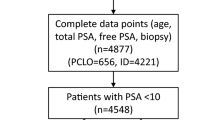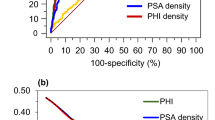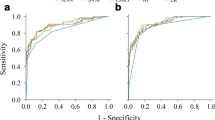Abstract
Use of percent free PSA (%fPSA) and artificial neural networks (ANNs) can eliminate unnecessary prostate biopsies. In a total of 4,480 patients from five centers with PSA concentrations in the range of 2–10 ng/ml an IMMULITE PSA-based ANN (iANN) was compared with other PSA assay-adapted ANNs (nANNs) to investigate the impact of different PSA assays. ANN data were generated with PSA, fPSA (assays from Abbott, Beckman, DPC, Roche or Wallac), age, prostate volume, and DRE status. In 15 different ROC analyses, the area under the curve (AUC) in the PSA ranges 2–4, 2–10, and 4–10 ng/ml for the nANN was always significantly larger than the AUC for %fPSA or PSA. The nANN and logistic regression models mostly also performed better than the iANN. Therefore, for each patient population, PSA assay-specific ANNs should be used to optimize the ANN outcome in order to reduce the number of unnecessary biopsies.
Similar content being viewed by others
References
Polascik TJ, Oesterling JE, Partin AW (1999) Prostate specific antigen: a decade of discovery—what we have learned and where we are going. J Urol 162:293–306
Thompson IM, Pauler DK, Goodman PJ, Tangen CM, Lucia MS, Parnes HL, Minasian LM, Ford LG, Lippman SM, Crawford ED, Crowley JJ, Coltman CA Jr (2004) Prevalence of prostate cancer among men with a prostate-specific antigen level < or = 4.0 ng per milliliter. N Engl J Med 350:2239–2246
Lilja H, Christensson A, Dahlen U, Matikainen MT, Nilsson O, Pettersson K, Lövgren T (1991) Prostate-specific antigen in serum occurs predominantly in complex with alpha 1–antichymotrypsin. Clin Chem 37:1618–1625
Stenman UH, Leinonen J, Alfthan H, Rannikko S, Tuhkanen K, Alfthan O (1991) A complex between prostate-specific antigen and alpha 1–antichymotrypsin is the major form of prostate-specific antigen in serum of patients with prostatic cancer: assay of the complex improves clinical sensitivity for cancer. Cancer Res 51:222–226
Catalona WJ, Partin AW, Slawin KM, Brawer MK, Flanigan RC, Patel A, Richie JP, deKernion JB, Walsh PC, Scardino PT, Lange PH, Subong EN, Parson RE, Gasior GH, Loveland KG, Southwick PC (1998) Use of the percentage of free prostate-specific antigen to enhance differentiation of prostate cancer from benign prostatic disease: a prospective multicenter clinical trial. JAMA 279:1542–1547
Partin AW, Catalona WJ, Southwick PC, Subong EN, Gasior GH, Chan DW (1996) Analysis of percent free prostate-specific antigen (PSA) for prostate cancer detection: influence of total PSA, prostate volume, and age. Urology 48:55–61
Stephan C, Stroebel G, Heinau M, Lenz A, Roemer A, Lein M, Schnorr D, Loening SA, Jung K (2005) The ratio of prostate-specific antigen (PSA) to prostate volume (PSA density) as a parameter to improve the detection of prostate carcinoma in PSA values in the range of <4 ng/mL. Cancer 104:993–1003
Catalona WJ, Partin AW, Finlay JA, Chan DW, Rittenhouse HG, Wolfert RL, Woodrum DL (1999) Use of percentage of free prostate-specific antigen to identify men at high risk of prostate cancer when PSA levels are 2.51 to 4 ng/mL and digital rectal examination is not suspicious for prostate cancer: an alternative model. Urology 54:220–224
Jung K, Stephan C, Elgeti U, Lein M, Brux B, Kristiansen G, Rudolph B, Hauptmann S, Schnorr D, Loening SA (2001) Molecular forms of prostate-specific antigen in serum with concentrations of total prostate-specific antigen <4 μg/l—are they useful tools for early detection and screening of prostate cancer? Int J Cancer 93:759–765
Lee CT, Scardino PT (2001) Percent free Prostate-specific antigen for first-time prostate biopsy. Urology 57:594–598
Stephan C, Lein M, Jung K, Schnorr D, Loening SA (1997) Can prostate specific antigen derivatives reduce the frequency of unnecessary prostate biopsies? [Letter]. J Urol 157:1371
Haese A, Graefen M, Noldus J, Hammerer P, Huland E, Huland H (1997) Prostatic volume and ratio of free-to-total prostate specific antigen in patients with prostatic cancer or benign prostatic hyperplasia. J Urol 158:2188–2192
Mettlin C, Chesley AE, Murphy GP, Bartsch G, Toi A, Bahnson R, Church P (1999) Association of free PSA percent, total PSA, age, and gland volume in the detection of prostate cancer. Prostate 39:153–158
Stephan C, Lein M, Jung K, Schnorr D, Loening SA (1997) The influence of prostate volume on the ratio of free to total prostate specific antigen in serum of patients with prostate carcinoma and benign prostate hyperplasia. Cancer 79:104–109
Lein M, Koenig F, Jung K, McGovern FJ, Skates SJ, Schnorr D, Loening SA (1998) The percentage of free prostate specific antigen is an age-independent tumour marker for prostate cancer: establishment of reference ranges in a large population of healthy men. Br J Urol 82:231–236
Carlson GD, Calvanese CB, Partin AW (1998) An algorithm combining age, total prostate-specific antigen (PSA), and percent free PSA to predict prostate cancer: results on 4298 cases. Urology 52:455–461
Virtanen A, Gomari M, Kranse R, Stenman UH (1999) Estimation of prostate cancer probability by logistic regression: free and total prostate-specific antigen, digital rectal examination, and heredity are significant variables. Clin Chem 45:987–994
Babaian RJ, Fritsche H, Ayala A, Bhadkamkar V, Johnston DA, Naccarato W, Zhang Z (2000) Performance of a neural network in detecting prostate cancer in the prostate-specific antigen reflex range of 2.5 to 4.0 ng/ml. Urology 56:1000–1006
Djavan B, Remzi M, Zlotta A, Seitz C, Snow P, Marberger M (2002) Novel artificial neural network for early detection of prostate cancer. J Clin Oncol 20:921–929
Finne P, Finne R, Auvinen A, Juusela H, Aro J, Maattanen L, Hakama M, Rannikko S, Tammela TL, Stenman U (2000) Predicting the outcome of prostate biopsy in screen-positive men by a multilayer perceptron network. Urology 56:418–422
Remzi M, Anagnostou T, Ravery V, Zlotta A, Stephan C, Marberger M, Djavan B (2003) An artificial neural network to predict the outcome of repeat prostate biopsies. Urology 62:456–460
Stephan C, Jung K, Cammann H, Vogel B, Brux B, Kristiansen G, Rudolph B, Hauptmann S, Lein M, Schnorr D, Sinha P, Loening SA (2002) An artificial neural network considerably improves the diagnostic power of percent free prostate-specific antigen in prostate cancer diagnosis: results of a 5-year investigation. Int J Cancer 99:466–473
Kalra P, Togami J, Bansal BSG, Partin AW, Brawer MK, Babaian RJ, Ross LS, Niederberger CS (2003) A neurocomputational model for prostate carcinoma detection. Cancer 98:1849–1854
Partin AW, Murphy GP, Brawer MK (2000) Report on prostate cancer tumor marker workshop 1999. Cancer 88:955–963
Jung K, Stephan C, Lein M, Henke W, Schnorr D, Brux B, Schürenkämper P, Loening SA (1996) Analytical performance and clinical validity of two free prostate-specific antigen assays compared. Clin Chem 42:1026–1033
Oberpenning F, Weining C, Brandt B, De Angelis G, Heinecke A, Hamm M, Stieber P, Hertle L, Schmid HP, Semjonow A (2002) Combining free and total prostate specific antigen assays from different manufacturers: the pitfalls. Eur Urol 42:577–582
Patel D, White PA, Milford WA (2000) A comparison of six commercial assays for total and free prostate specific antigen (PSA): the predictive value of the ratio of free to total PSA. BJU Int 85:686–689
Semjonow A, Oberpenning F, Brandt B, Zechel C, Brandau W, Hertle L (1996) Impact of free prostate-specific antigen on discordant measurement results of assays for total prostate-specific antigen. Urology 48(Suppl):10–15
Yurdakul G, Bangma C, Blijenberg B, van Zelst B, Wildhagen M, van der KT, Schroder F (2002) Different PSA assays lead to detection of prostate cancers with identical histological features. Eur Urol 42:154–158
Stephan C, Cammann H, Semjonow A, Diamandis EP, Wymenga LFA, Lein M, Sinha P, Loening SA, Jung K (2002) Multicenter evaluation of an artificial neural network to increase prostate cancer detection rate and reduce unnecessary biopsies. Clin Chem 48:1279–1287
Hodge KK, McNeal JE, Terris MK, Stamey TA (1989) Random systematic versus directed ultrasound guided transrectal core biopsies of the prostate. J Urol 142:71–74
Romics I (2004) The technique of ultrasound guided prostate biopsy. World J Urol 22:353–356
Woodrum D, York L (1998) Two-year stability of free and total PSA in frozen serum samples. Urology 52:247–251
Blijenberg BG, Yurdakul G, Van Zelst BD, Bangma CH, Wildhagen MF, Schroder FH (2001) Discordant performance of assays for free and total prostate-specific antigen in relation to the early detection of prostate cancer. BJU Int 88:545–550
Jung K, Stephan C, Lein M, Brux B, Sinha P, Schnorr D, Loening SA (2001) Receiver-operating characteristic as a tool for evaluating the diagnostic performance of prostate-specific antigen and its molecular forms—What has to be considered? Prostate 46:307–310
Stephan C, Jung K, Lein M, Sinha P, Schnorr D, Loening SA (2000) Molecular forms of prostate-specific antigen and human kallikrein 2 as promising tools for early diagnosis of prostate cancer. Cancer Epidemiol Biomarkers Prev 9:1133–1147
Schroder FH, Kranse R (2003) Verification bias and the prostate-specific antigen test—is there a case for a lower threshold for biopsy? N Engl J Med 349:393–395
Roehl KA, Antenor JA, Catalona WJ (2002) Robustness of free prostate specific antigen measurements to reduce unnecessary biopsies in the 2.6 to 4.0 ng./ml. range. J Urol 168:922–925
Semjonow A, Brandt B, Oberpenning F, Roth S, Hertle L (1996) Discordance of assay methods creates pitfalls for the interpretation of prostate-specific antigen values. Prostate Suppl 7:3–16
Sargent DJ (2001) Comparison of artificial neural networks with other statistical approaches. Cancer 91:1636–1642
Acknowledgments
We gratefully acknowledge Paul E. C. Sibley for his helpful corrections. We thank S. Kreuzer, C. Wülfing, and J. Chun for helpful database support. This work was partly supported by the Mildred-Scheel-Foundation (Grant 70-3295-ST1 to C.S., H.C., K.J.), the Berliner Sparkassenstiftung Medizin (to C.S., H.C.), and the Monika-Kutzner-Stiftung (to C.S., K.J., H.C.).
Author information
Authors and Affiliations
Corresponding author
Rights and permissions
About this article
Cite this article
Stephan, C., Xu, C., Cammann, H. et al. Assay-specific artificial neural networks for five different PSA assays and populations with PSA 2–10 ng/ml in 4,480 men. World J Urol 25, 95–103 (2007). https://doi.org/10.1007/s00345-006-0132-9
Received:
Accepted:
Published:
Issue Date:
DOI: https://doi.org/10.1007/s00345-006-0132-9




